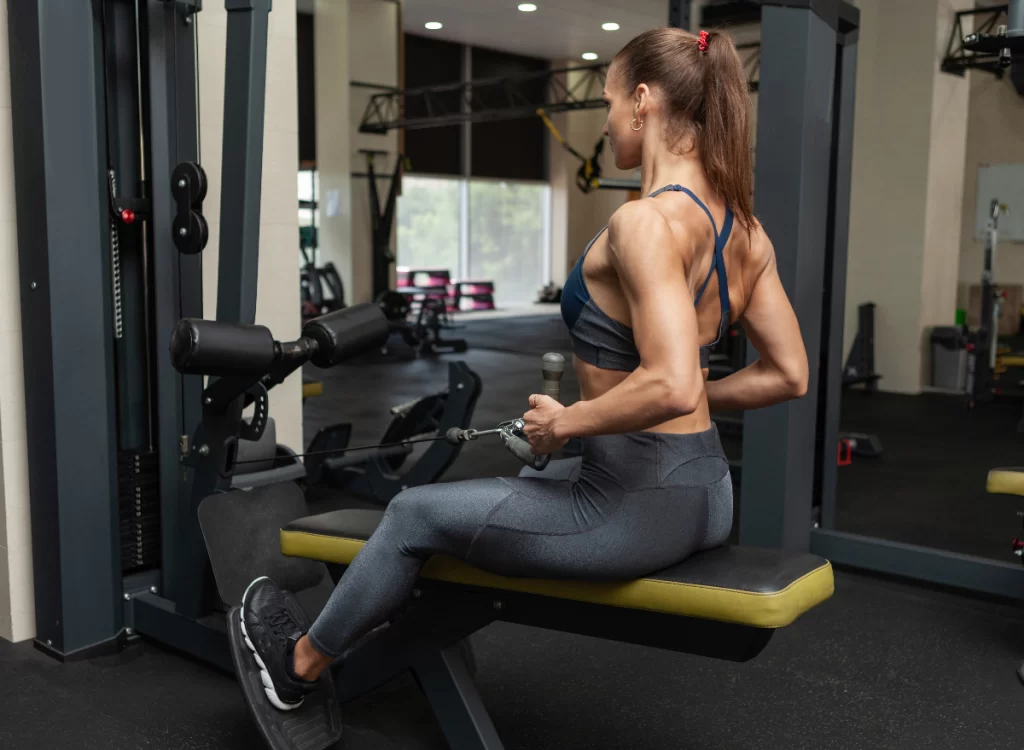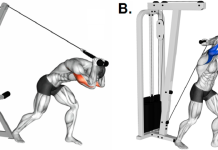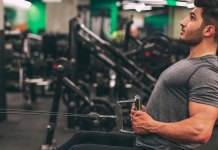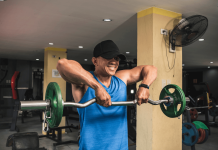The Ultimate Guide to Effective Cable Exercises for a Strong and Sculpted Back
A strong and sculpted back not only enhances your physique but also improves posture and overall strength. Among the various workout techniques available, cable exercises for back muscles stand out for their targeted engagement and versatility. In this comprehensive guide, we will explore the most effective cable exercises to strengthen and sculpt your back, helping you achieve impressive results and a well-defined back.

Cable Rows: Building Back Muscles
Cable rows are a fundamental cable exercise that targets the major muscles of the back, including the lats, rhomboids, and trapezius. Mastering cable rows is essential for developing a powerful and well-defined back. Follow these tips to get the most out of your cable row workouts:
- Proper Form and Technique: Maintain a neutral spine, engage your core, and pull the cable towards your abdomen while squeezing your shoulder blades together.
- Different Variations: Explore different cable rows variations, such as seated cable rows and single-arm cable rows, to activate different muscle fibers.
- Progressive Overload: Gradually increase the resistance over time to challenge your back muscles and stimulate growth.
Lat Pulldowns: Strengthening the Lats
Lat pulldowns are an excellent cable exercise for targeting the latissimus dorsi muscles, commonly known as the lats. Strengthening the lats not only contributes to an impressive V-shaped back but also enhances upper-body pulling strength. Follow these guidelines to maximize the benefits of lat pulldowns:
- Wide-Grip and Narrow-Grip Techniques: Vary your grip width to target different areas of the lats. Wide-grip lat pulldowns emphasize the outer lats, while narrow-grip pulldowns target the inner lats.
- Proper Lat Activation: Initiate the movement from your lats, focusing on pulling your elbows down and back to engage the target muscles fully.
- Mind-Muscle Connection: Establish a strong mind-muscle connection by visualizing your lats contracting during each repetition.
Cable Pull-Throughs: Activating the Lower Back
Cable pull-throughs are an effective exercise for targeting the lower back muscles, glutes, and hamstrings. This exercise helps develop a strong lower back and posterior chain, contributing to better spinal stability. Here’s how to perform cable pull-throughs with optimal form:
- Setup: Attach a rope handle to the cable machine at the lowest setting. Stand facing away from the machine with your feet shoulder-width apart.
- Hinging Movement: Hinge at the hips while keeping your back straight and core engaged. Push your hips back until you feel a stretch in your hamstrings.
- Activation: Explosively contract your glutes and thrust your hips forward, pulling the cable through your legs until you reach a standing position.
- Controlled Return: Slowly return to the starting position by hinging at the hips and maintaining tension in your glutes and hamstrings.
Face Pulls: Developing Upper Back Muscles
Face pulls are a must-have exercise in any cable back workout routine, as they target the rear deltoids and upper back muscles. Strengthening these areas helps improve posture and overall shoulder stability. To perform face pulls effectively:
- Adjust the Cable Machine: Set the cable machine at chest height and attach a rope handle. Stand with your feet shoulder-width apart, facing the machine.
- Grip and Position: Hold the rope with a neutral grip (palms facing each other) and step back to create tension in the cable.
- Initiate the Movement: Pull the rope towards your face by squeezing your shoulder blades together. Focus on bringing your elbows back and keeping them at shoulder height.
- Mindful Retraction: As the rope approaches your face, focus on retracting your shoulder blades and squeezing the rear delts.
- Controlled Release: Slowly extend your arms back to the starting position, maintaining tension in the upper back muscles.
Cable Deadlifts: Strengthening the Entire Back
Cable deadlifts are a versatile exercise that engages the entire back, along with the core and lower body. These compound movements are highly effective for building overall strength and muscle mass. Follow these steps for cable deadlifts:
- Setup: Stand facing the cable machine with your feet hip-width apart. Attach a straight bar or handle to the low cable.
- Grip and Posture: Grab the bar with an overhand grip, hands shoulder-width apart. Keep your back straight, chest up, and core engaged.
- Lifting Motion: Initiate the lift by pushing your hips back and bending at the knees. Lower the bar towards the ground while keeping it close to your body.
- Full Extension: Thrust your hips forward and stand tall, bringing the bar to your hips as you fully extend your body.
- Controlled Descent: Lower the bar back to the starting position with control, maintaining tension in your back and legs.
Renegade Rows: Engaging the Core and Back
Renegade rows are a challenging but rewarding exercise that targets both the back and core muscles. They also improve stability and coordination. To perform renegade rows:
- Positioning: Start in a plank position with your hands gripping two dumbbells or kettlebells, shoulder-width apart.
- Rowing Motion: Initiate the row by pulling one dumbbell towards your torso while stabilizing your body with the opposite arm.
- Core Engagement: Engage your core to prevent rotation and keep your body aligned throughout the movement.
- Alternate Sides: Lower the dumbbell back to the ground and repeat the row on the opposite side.
One-Arm Cable Pulldowns: Focusing on Unilateral Strength
One-arm cable pulldowns isolate each side of the back individually, allowing for better focus and muscle activation. Here’s how to perform one-arm cable pulldowns:
- Setup: Stand sideways to the cable machine and grip the handle with one hand, palm facing down.
- Pulling Motion: Pull the handle down and across your body towards your hip while focusing on engaging the lat of the working side.
- Controlled Release: Slowly return the handle to the starting position and repeat the movement on the opposite side.
Seated Cable Rows: Enhancing Mid-Back Muscles
Seated cable rows are a classic exercise that targets the mid-back muscles, including the rhomboids and middle trapezius. To perform seated cable rows effectively:
- Machine Setup: Sit on the cable row machine with your feet on the footrests. Grip the handles with an overhand grip, hands shoulder-width apart.
- Pulling Motion: Pull the handles towards your torso, squeezing your shoulder blades together. Focus on using your back muscles rather than relying on your arms.
- Controlled Release: Slowly extend your arms back to the starting position while maintaining tension in your back.
Cable Reverse Flyes: Developing the Rear Deltoids
Cable reverse flies target the rear deltoids and upper back, helping to improve shoulder stability and posture. To perform cable reverse flyes correctly:
- Setup: Set the cable machine at the lowest position and attach D-handles. Stand facing the machine with your feet hip-width apart.
- Grip and Position: Hold the handles with your palms facing each other. Slightly bend your elbows and maintain a slight forward lean from your hips.
- Flye Motion: Open your arms wide to the sides, squeezing your shoulder blades together. Focus on engaging the rear delts throughout the movement.
- Controlled Return: Slowly bring the handles back to the starting position, maintaining tension in your rear delts and upper back.
Cable Exercises for Back: Sample Workout Routine
Here’s a sample cable workout routine to target your entire back effectively:
- Cable Rows: 3 sets x 10-12 reps
- Lat Pulldowns: 3 sets x 8-10 reps
- Cable Pull Throughs: 3 sets x 12-15 reps
- Face Pulls: 3 sets x 12-15 reps
- Cable Deadlifts: 3 sets x 8-10 reps
- Renegade Rows: 3 sets x 10 reps per side
- One-Arm Cable Pulldowns: 3 sets x 12 reps per side
- Seated Cable Rows: 3 sets x 10-12 reps
- Cable Reverse Flyes: 3 sets x 12-15 reps
Tips for an Effective Cable Back Workout
- Always Warm Up: Prioritize a dynamic warm-up to increase blood flow to your back muscles and reduce the risk of injury.
- Focus on Form: Maintain proper form throughout each exercise to ensure maximum muscle activation and prevent strain.
- Mind-Muscle Connection: Establish a strong mind-muscle connection by visualizing your back muscles working during each movement.
- Progressive Overload: Gradually increase the weight or resistance as you progress to continuously challenge your muscles.
- Include Rest Days: Allow your back muscles adequate time to recover and grow by incorporating rest days into your workout routine.
- Mix It Up: Periodically change the exercises and their order to keep your back muscles stimulated and prevent plateaus.
- Listen to Your Body: Pay attention to your body’s signals and adjust your workout intensity and volume accordingly.
Incorporating cable exercises into your back workout routine can elevate your training to new heights, helping you achieve a strong and sculpted back. From cable rows to face pulls, each exercise targets different back muscles for a well-rounded and effective workout. Remember to focus on proper form, use progressive overload, and maintain a strong mind-muscle connection for optimal results. With dedication and consistency, you can transform your back and enhance your overall strength and athleticism. Happy training!




